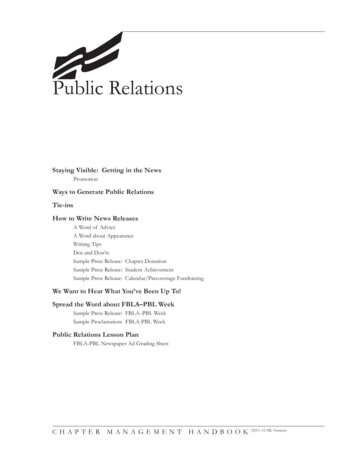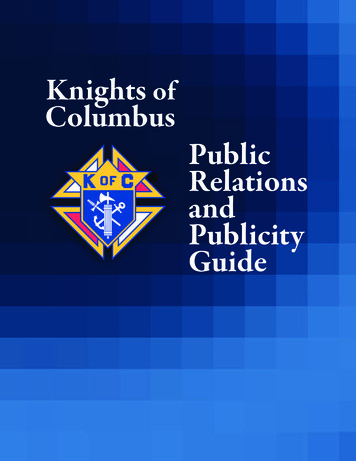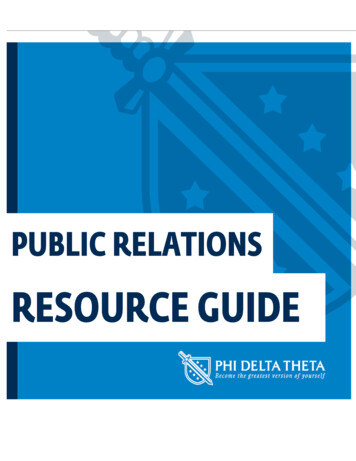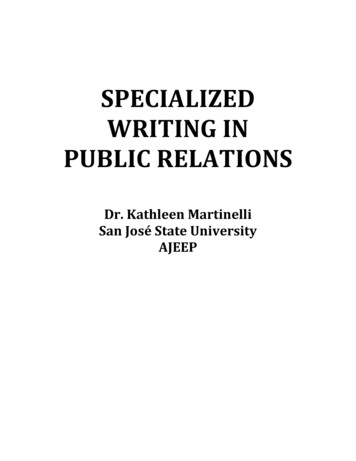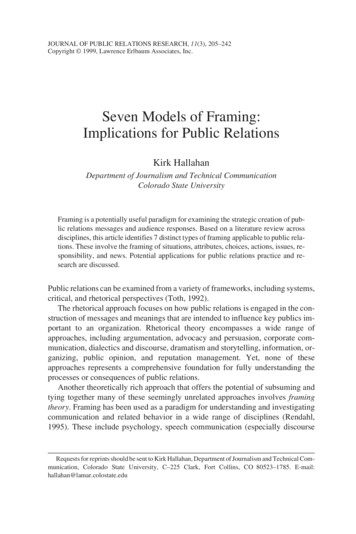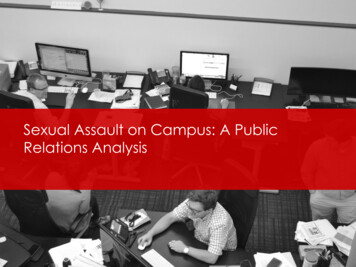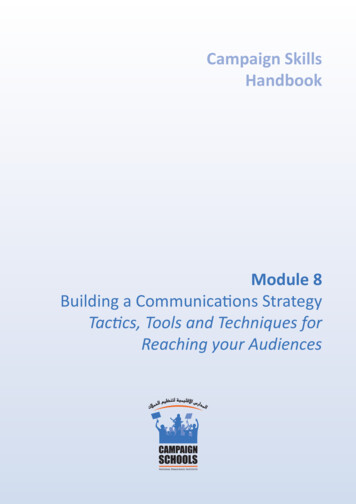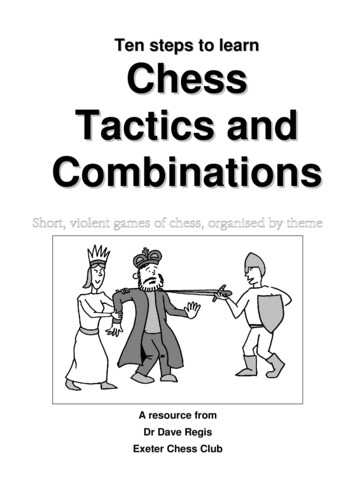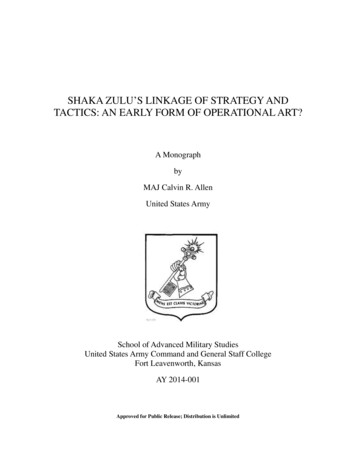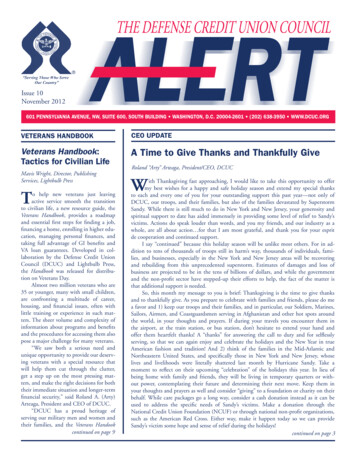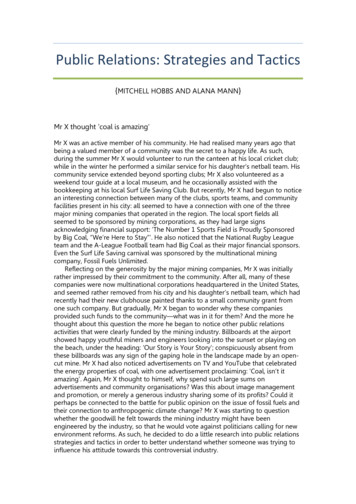
Transcription
Public Relations: Strategies and Tactics{MITCHELL HOBBS AND ALANA MANN}Mr X thought ‘coal is amazing’Mr X was an active member of his community. He had realised many years ago thatbeing a valued member of a community was the secret to a happy life. As such,during the summer Mr X would volunteer to run the canteen at his local cricket club;while in the winter he performed a similar service for his daughter’s netball team. Hiscommunity service extended beyond sporting clubs; Mr X also volunteered as aweekend tour guide at a local museum, and he occasionally assisted with thebookkeeping at his local Surf Life Saving Club. But recently, Mr X had begun to noticean interesting connection between many of the clubs, sports teams, and communityfacilities present in his city: all seemed to have a connection with one of the threemajor mining companies that operated in the region. The local sport fields allseemed to be sponsored by mining corporations, as they had large signsacknowledging financial support: ‘The Number 1 Sports Field is Proudly Sponsoredby Big Coal, “We’re Here to Stay”’. He also noticed that the National Rugby Leagueteam and the A-League Football team had Big Coal as their major financial sponsors.Even the Surf Life Saving carnival was sponsored by the multinational miningcompany, Fossil Fuels Unlimited.Reflecting on the generosity by the major mining companies, Mr X was initiallyrather impressed by their commitment to the community. After all, many of thesecompanies were now multinational corporations headquartered in the United States,and seemed rather removed from his city and his daughter’s netball team, which hadrecently had their new clubhouse painted thanks to a small community grant fromone such company. But gradually, Mr X began to wonder why these companiesprovided such funds to the community—what was in it for them? And the more hethought about this question the more he began to notice other public relationsactivities that were clearly funded by the mining industry. Billboards at the airportshowed happy youthful miners and engineers looking into the sunset or playing onthe beach, under the heading: ‘Our Story is Your Story’; conspicuously absent fromthese billboards was any sign of the gaping hole in the landscape made by an opencut mine. Mr X had also noticed advertisements on TV and YouTube that celebratedthe energy properties of coal, with one advertisement proclaiming: ‘Coal, isn’t itamazing’. Again, Mr X thought to himself, why spend such large sums onadvertisements and community organisations? Was this about image managementand promotion, or merely a generous industry sharing some of its profits? Could itperhaps be connected to the battle for public opinion on the issue of fossil fuels andtheir connection to anthropogenic climate change? Mr X was starting to questionwhether the goodwill he felt towards the mining industry might have beenengineered by the industry, so that he would vote against politicians calling for newenvironment reforms. As such, he decided to do a little research into public relationsstrategies and tactics in order to better understand whether someone was trying toinfluence his attitude towards this controversial industry.
Public Relations: Strategies and TacticsIntroduction: Public relations and the marketplace of ideasOur twenty-first century society is saturated by media images and information. Mediaconglomerates, public service broadcasters, social media, advertisers and others all competefor our attention and limited cogitative capacity. This cornucopia of information and imagesis empowering, entertaining and informative, and it is the lifeblood of our glittering consumersocieties. This system of communication also connects us in ways that were impossible forprevious societies. In 1869, the British philosopher John Stuart Mill (1913) wrote that a freesociety is one in which all individuals can speak and exchange ideas in, what would later becalled, a ‘marketplace of ideas’ (Martinelli, 2011: 34). Today’s marketplace of ideas is acrowded place. In order to be heard amidst the cacophony of voices, public relationsspecialists use strategic communication to champion and promote the messages and images oftheir employers.Public relations is a profession dedicated to the effective use of communication. And yetthis definition is far too simple as public relations is so much more than communicating onbehalf of corporations, institutions and other organisations. According to Grunig and Hunt(1984: 6) public relations is about ‘the management of communication between anorganisation and its publics’. Cutlip et al. (2000: 6) expands on this definition: ‘publicrelations is the management function that establishes and maintains mutually beneficialrelationships between an organisation and the publics on whom its success or failure depends’.Similarly, Harlow (1976: 36) describes the profession as the ‘management function’ thatmaintains ‘mutual lines of communication’ between an organisation and its publics, andwhich uses ‘research and ethical communication as its principal tools’. As these definitionshighlight, public relations is a diverse profession that seeks to ensure that organisationsmanage their relationships with a variety of stakeholders and broader publics (see Martinelli,2011: 34).In order to manage the public image and stakeholder relationships of companies andorganisations, public relations practitioners employ a variety of communication tactics,including media releases, social media accounts, media events, backgrounders, fact sheets,flyers, pamphlets, annual reports, newsletters, and other materials. Senior practitioners areresponsible for planning the details of ‘what, how and why their organisations communicatewith strategic publics’ (Mahoney, 2013: 2). As leaders of a communications team, seniorpractitioners are often part of an organisation ‘dominant management coalition’ (that is, itsmost senior managers) (Mahoney, 2013: 2). These senior practitioners are responsible forprotecting the company’s public reputation by identifying issues, and by using effectivecommunication to align the interests of organisations with those of the significant publics intheir operating environment (Grunig, Grunig & Dozier 2006: 55).This chapter introduces the profession of public relations. Rather than providing merely adescriptive account of ‘how to do PR’, it offers a critical overview of the profession,including its history, strategies, tactics and ethical guidelines. This discussion will provide thereader with a smorgasbord of ideas that can inform ‘best practice’ within public relationsroles. This chapter also provides several illustrative case studies designed to showcase thediverse activities that a public relations practitioner undertakes. This discussion begins byconsidering the historical development of public relations and its contemporary reach andinfluence.Mitchell Hobbs and Alana Mann2
Public Relations: Strategies and TacticsMedia releases: Media releases are written in an active voice and provide information fornews stories. Good media releases conform to journalistic conventions, such as the ‘invertedpyramid’ of news writing, and answer the standard questions: who, what, when, where, why,and how.Backgrounders: Unlike a media release, a backgrounder is written in chronological order ornarrative fashion, and is used to provide important ‘background information’ to contextualisean event, person, or issue.Fact sheets: As the name suggests, fact sheets are a public relations tactic used to provide aconcise summary of relevant facts that a journalist might include in a news story, such asstatistics or a timeline of key events.Public relations: A short historyPublic relations is commonly considered to be a ‘young profession’—a type ofcommunications byproduct of twentieth-century capitalism. However, the techniques oforganised and persuasive communication are in fact as old as human societies. As StephenStockwell (2007: 139) argues, the songs of the shaman were used to unify tribal communitiesthroughout history. Likewise, the ballads of ancient bards preserved the myths and legendsthat ‘bound together nascent nations’ (Stockwell, 2007: 139). Yet, perhaps the best historicalexample of professional communicators is found in ancient Greece, where the Sophistsdeveloped and taught the ‘art of rhetoric’. According to the great philosopher Aristotle,rhetoric was an important dimension of public life and Athenian democracy as it allowedassemblies of citizens to debate and then decide what was in their best interests (Stockwell,2007: 140). These rhetorical exchanges were the essence of their early form of deliberativedemocracy and are a communicative tradition that continues today in parliaments around theworld.Aristotle’s writings on rhetoric are the first comprehensive studies of strategiccommunication and its impacts. While Aristotle recognised that the techniques of rhetoricmay be used to manipulate, he believed the free play of communication in the rhetorical fieldproduced a self-correcting mechanism conducive to the production of consensualunderstandings and truth:[The exchange of rhetoric allows] a contest that brings forth the best among those whooffer opposed positions on practical questions [so that] the audience is engaged in such away that allows it to see more clearly and act more judiciously. (Aristotle cited inStockwell, 2007: 140).Some of Aristotle’s ideas are still seen in the contemporary practices of political publicrelations and democratic politics. For instance, Aristotle argued that the elements ofpersuasive speech are ‘ethos’, ‘pathos’ and ‘logos’ (Martinelli, 2011: 34). Ethos refers to thecredibility and trustworthiness of the speaker. Pathos refers to rhetorical appeals to emotionsand belief systems, and in its modern usage can include the use of stories, inspirational quotesor vivid language. Finally, logos refers to the quality of the logic and reasoning within anargument. All of these dimensions of rhetoric are still considered by contemporary publicrelations practitioners when they employ communication campaigns that seek to build supportfor a particular person or brand, or when using third-party spokespersons for an endorsement(Martinelli, 2011: 34).Mitchell Hobbs and Alana Mann3
Public Relations: Strategies and TacticsWhile the distant roots of public relations lie in the art of rhetoric practiced by the ancientGreeks, other notable developments accompanied important political events throughouthistory. In mediaeval European society, both church and state sought to dominate publicopinion and used preaching, painting, scripture, songs, rituals, events and publicannouncements as forms of communicative influence (Harrison, 2011: 41). Likewise, duringthe Counter-Reformation in seventeenth-century, the Roman Catholic Church developed theterm ‘propaganda’ to refer to communication that sought to influence public opinion(Harrison, 2011: 42). Propaganda, often in the form of pamphlets, subsequently became anotable feature of major political or military events, from the French Revolution andNapoleonic Wars to the promotion of British Empire and the colonisation of the ‘new world’.Many histories of public relations see the modern profession emerging in the UnitedStates in the 1800s and early 1900s. In the 1830s, a new type of communications professionalemerged in the form of a ‘press agent’, as companies and promoters sought new ways ofcommunicating with the public rather than paying for costly advertisements in newspapers(Harrison, 2011). The role of the press agent was to concoct news stories in order to gain theattention of journalists, thus receiving free publicity regarding an event such as a visitingcircus; a product, such as the latest medical elixir; or a cause, such as the anti-slavery moment.However, according to Kim Harrison’s (2011) history of public relations, the press agentmodel of public relations was not without controversy. Indeed, from the late 1800s, labourmovements and the broader public started to seek more accountability and transparency frombig business and government.The public began to recognize that unattributed editorial information was being suppliedto newspapers in secret deals. When corporations came to understand that using secretpress agents to spread news to newspapers led to even worse public opinion, many optedfor greater openness and adopted a proactive stance. (Harrison, 2011: 49-50)It was in the early twentieth-century that a demand for more ethical communicationbetween companies and the mass media set the stage for the emergence of a new type ofcommunications professional: the public relations specialist. In particular, two individuals,Ivy Lee and Edward Bernays, are often identified as the ‘founding fathers’ of modern publicrelations due their influence on shaping the principles and practices of the emergingprofession (Martinelli, 2011: 36-38).Ivy Lee (1877–1934) started his career as business journalist before entering politicalpublicity as a press agent, starting his own firm in New York City in 1904. Lee was a newtype of publicist in that he did not conceal that he was being paid to have stories of his clientspublished in the press. Indeed, Lee and his business partner George Parker coauthored aninfluential ‘Declaration of Principles’ that he sent to newspaper editors, and in which hepledge his firm to providing a new standard of professionalism: ‘accurate information’ aboutsubjects of interest to the public.This is not a secret press bureau. All our work is done in the open. We aim to supplynews. This is not an advertising agency; if you think any of our matter ought properly togo to your business office, do not use it. Our matter is accurate. Further details on anysubject treated will be supplied promptly, and any editor will be assisted most cheerfullyin verifying directly any statement of fact. (Lee and Harper cited in Harrison, 2011: 49).Mitchell Hobbs and Alana Mann4
Public Relations: Strategies and TacticsLee also introduced several important communication tactics that supported hiscommitment to fair and transparent dealings. The first was the idea of a ‘press release’‘handout’ that detailed the client’s message and provided factual information for journalists ina manner that was transparent, accountable and useful (with the media release now being oneof the most common tactics in the PR toolkit). His second innovation was the idea ofopenness and disclosure during a crisis. For instance, following a major rail accident thatresulted in the deaths of 50 passengers, Lee convinced managers to provide information aboutthe accident before rumour and speculation took hold of the news cycle. He also invitedjournalists to the scene and actively assisted with their enquires, rather than seeking tostonewall their investigations (Harrison, 2011: 53). This approach to crisis management wasseen as more socially legitimate than previous attempts by companies to bury information andkeep journalists at a distance. It also helped companies minimise damage to their publicimage by highlighting individual failures within a broader system that, despite facing acurrent crisis or issue, continued to have benefits for society (such as providing employment,services, tax revenue, etc.) (Coombs, 2006). While Lee died relatively young at the age of 57,his principled tactics had widespread appeal and a lasting impact on media relations andcrisis communication—two important subspecialisations within the broader field of publicrelations (Harrison, 2011).Media relations: Media relations is the aspect of public relations which involves dealingdirectly with media workers, such as journalists, editors, and producers. Media relationspractitioners seek to use their conducts within the media industry to disseminate clientmessages within news items.Crisis communication: Crisis communication is used by an organisation following a majorcrisis that threatens their image and financial performance. Crises can be internal or externalin origin. For instance, an internal crisis might arise as the result of a major industrial relationsdispute or product failure, while an external crisis might result from a natural disaster ormacro-economic forces.In contrast to Lee, Edward Bernays (1891–1995) is a more controversial figure in thehistory of public relations (Martinelli, 2011: 36–38). Bernays was the nephew of the famouspsychologist Sigmund Freud, and introduced ideas from psychology and sociology into thepractice of public relations. He began his career as a press agent in 1913, but coined the term‘public relations counsel’ to describe his activities in 1921 (Harrison, 2011: 55). Bernays alsowrote many influential books on public relations and public opinion and taught the firstuniversity course specifically entitled ‘public relations’ at New York University in 1923. LikeLee, Bernays viewed the role of the public relations practitioner as an advocate in the arena ofpublic opinion, much as a lawyer is an advocate in the courtroom (Pfau & Wan, 2006: 101–102). Unlike Lee, Bernays viewed public relations as a form of strategic communication thatpractitioners should use to ‘engineer consent’ by creating messages that will resonate with thepublic (Pfau & Wan 2006: 101-102). Indeed, for Bernays persuasion was seen as an integralfunction of public relations and should be based on the scientific understanding of theaudience and the formation of public opinion: ‘Persuasion is an inseparable part of ademocratic way of life’ (Bernays cited in Pfau & Wan, 2006: 101–102).Bernays introduced several enduring tactics into the public relations toolkit that are stillused to persuade strategic publics to this day. One of these common tactics was the use ofMitchell Hobbs and Alana Mann5
Public Relations: Strategies and Tactics‘third party endorsements’, by which Bernays used ‘opinion leaders’, such as scientists orother experts, to offer public support for activities or products. As Harrison (2011) notes, thistactic works on the psychological principle of ‘social proof’, by which people decide what iscorrect by finding out what others believe to be correct. Bernays famously employed this‘third party’ technique for his client American Tobacco, using health experts to encourage theAmerican public to smoke cigarettes as a way to lose weight (Harrison, 2011: 56).Bernays also showed how it was possible to package a public relations message within abroader social movement or trend. For example, in the late 1920s, there was a social tabooconcerning women who smoked cigarettes in public. Bernays realised that if he couldchallenge and change this taboo he could expand the market reach of his client, AmericanTobacco (Coombs & Holladay, 2010: 149–151). To this end, he organised a pseudo-event, apublic protest march, in which ten beautiful women walked down Fifth Avenue in New Yorkduring the Easter Day parade to demonstrate that smoking in public was a sign of thewomen’s liberation movement rather than a sign of dubious character (Harrison 2011: 57). Atthat time, Bernays did not disclose that he had organised the ‘Torches of Freedom’ stunt, orthat his secretary was one of the participants; and thus the event drew a great deal of mediainterest (Coombs & Holladay, 2010: 150). Moreover, Bernays had demonstrated that theprofession of public relations might possess some of the same covert tactics of its progenitor,the press agentry.While many histories of public relations focus on the role of Edward Bernays, Ivy Leeand specific developments within the publicity industry in the United States, recent researchhas shown that professional communication was also emerging in other parts of the world(Harrison, 2011). Europe, the United Kingdom, Australia and elsewhere all had their ownhistories in the early development and use of press agents, propaganda, and other forms ofpersuasiv
Public relations is a profession dedicated to the effective use of communication. And yet this definition is far too simpl e as public relations is so much more than communicating on behalf of corporations, institutions and other organisations. According to Grunig and HuntFile Size: 407KB

